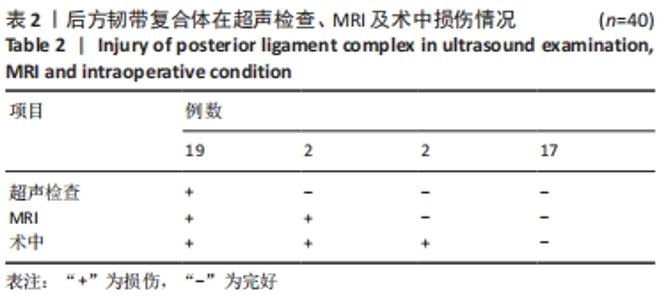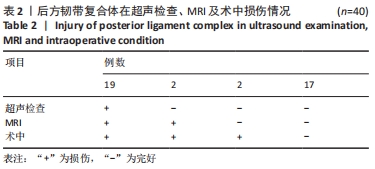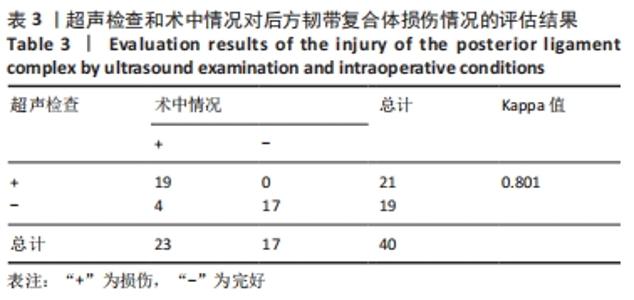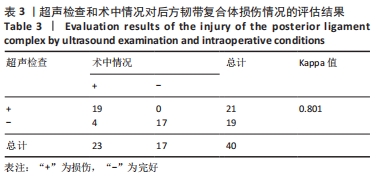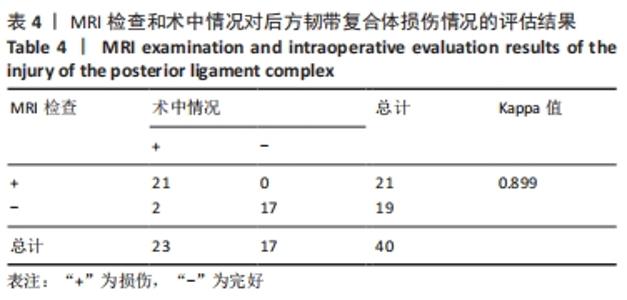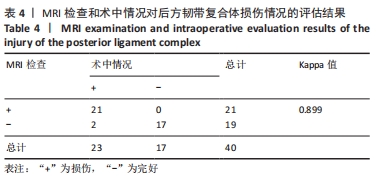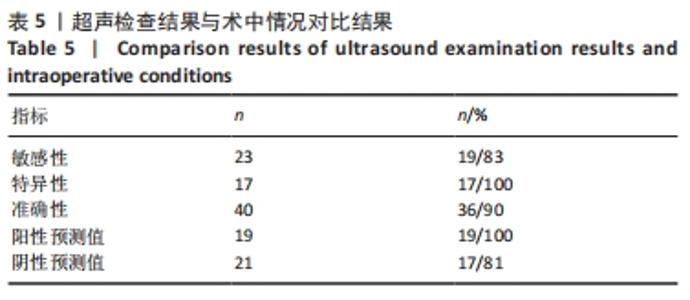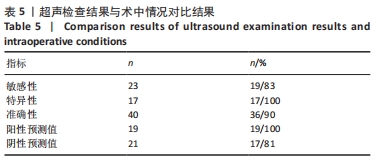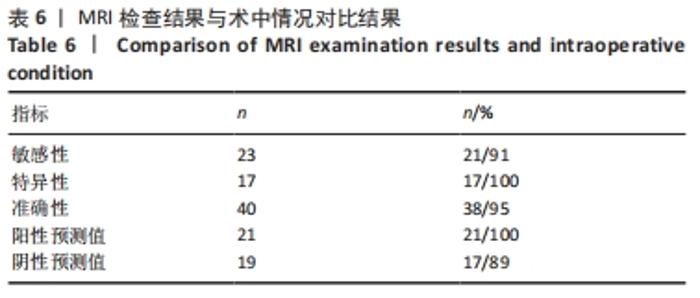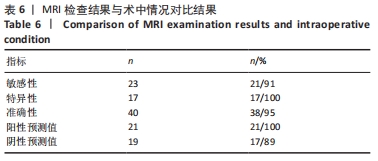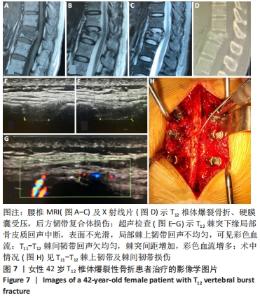Chinese Journal of Tissue Engineering Research ›› 2022, Vol. 26 ›› Issue (12): 1915-1921.doi: 10.12307/2022.516
Previous Articles Next Articles
Sensitivity and specificity of ultrasound in the assessment of posterior ligament complex injury in thoracolumbar fracture
Zhao Yuhui1, Gao Yue2, Xie Yanchun2, Gu Hongwen3, Li Linyang3, Yu Hailong2
- 1Jinzhou Medical University, Jinzhou 121001, Liaoning Province, China; 2General Hospital of Northern Theater Command, Shenyang 110016, Liaoning Province, China; 3Dalian Medical University, Dalian 116044, Liaoning Province, China
-
Received:2021-04-28Revised:2021-05-08Accepted:2021-07-06Online:2022-04-28Published:2021-12-14 -
Contact:Yu Hailong, Chief physician, General Hospital of Northern Theater Command, Shenyang 110016, Liaoning Province, China -
About author:Zhao Yuhui, Master, Jinzhou Medical University, Jinzhou 121001, Liaoning Province, China -
Supported by:Military Logistics Science Research Project in 2018, No. CLB18J047 (to YHL); Shenyang Science and Technology Planning Project in 2020, No. 20-205-4-023 (to XYC))
CLC Number:
Cite this article
Zhao Yuhui, Gao Yue, Xie Yanchun, Gu Hongwen, Li Linyang, Yu Hailong. Sensitivity and specificity of ultrasound in the assessment of posterior ligament complex injury in thoracolumbar fracture[J]. Chinese Journal of Tissue Engineering Research, 2022, 26(12): 1915-1921.
share this article
Add to citation manager EndNote|Reference Manager|ProCite|BibTeX|RefWorks
| [1] SETHI MK, SCHOENFELD AJ, BONO CM, et al. The evolution of thoracolumbar injury classification systems. Spine J. 2009;9:780-788. [2] VACCARO AR, ZEILLER SC, HULBERT RJ, et al. The thoracolumbar injury severity score: A proposed treatment algorithm. J Spinal Disord Tech. 2005;18:209-215. [3] PARK HJ, LEE SY, PARK NH, et al. Modified thoracolumbar injury classification and severity score (TLICS) and its clinical usefulness. Acta Radiol. 2016;57(1):74-81. [4] PARK CJ, KIM SK, LEE TM, et al. Clinical relevance and validity of TLICS system for thoracolumbar spine injury. Sci Rep. 2020;10(1):19494. [5] GANJEIFAR B, KEYKHOSRAVI E, BAHADORKHAN G, et al. Predictive Value of Computed Tomography Scan for Posterior Ligamentous Complex Injuries in Patients with Thoracolumbar Spinal Fractures. Arch Bone Jt Surg. 2019;7(4):321-324. [6] MAHESWARAN A, AIYER SN, FAROUK O, et al. Assessment of Interobserver Variability for CT Scan-Based Evaluation of Posterior Ligament Complex Injury in Thoracolumbar Fractures: An International Multicenter Pilot Study. Global Spine J. 2020;10(2):118-129. [7] MEHTA G, SHETTY UC, MEENA D, et al. Evaluation of Diagnostic Accuracy of Magnetic Resonance Imaging in Posterior Ligamentum Complex Injury of Thoracolumbar Spine. Asian Spine J. 2021;15(3): 333-339. [8] ZHAO JW, LIUY, YIN RF, et al. Ultrasound assessment of injury to the posterior ligamentous complex in patients with mild thoracolumbar fractures. J Int Med Res. 2013;41:1252-1257. [9] GANJEIFAR B, KEYKHOSRAVI E, BAHADORKHAN G, et al. Predictive Value of Computed Tomography Scan for Posterior Ligamentous Complex Injuries in Patients with Thoracolumbar Spinal Fractures. Arch Bone Jt Surg. 2019;7(4):321-324. [10] CHEN JX, GOSWAMI A, XU DL, et al. The radiologic assessment of posterior ligamentous complex injury in patients with thoracolumbar fracture. Eur Spine J. 2017;26(5):1454-1462. [11] PIZONES J, SÁNCHEZ-MARISCAL F, ZÚÑIGA L, et al. Prospective analysis of magnetic resonance imaging accuracy in diagnosing traumatic injuries of the posterior ligamentous complex of the thoracolumbarspine. Spine (Phila Pa 1976). 2013;38:745-751. [12] MARONGIU G, CONGIA S, VERONA M, et al. The impact of magnetic resonance imaging in the diagnostic and classification process of osteoporotic vertebral fractures. Injury. 2018;49 Suppl 3:S26-S31. [13] LI Z, GUAN M, SUN D, et al. A novel MRI- and CT-based scoring system to differentiate malignant from osteoporotic vertebral fractures in Chinese patients. BMC Musculoskelet Disord. 2018;19(1):406. [14] OISHI Y, NAKAMURA E, MURASE M, et al. Lower lumbar osteoporotic vertebral fractures with neurological symptoms might have two different pathogeneses according to early magnetic resonance images. Acta Neurochir (Wien). 2019;161(10):2211-2222. [15] KANEZAKI S, MIYAZAKI M, ISHIHARA T, et al. Magnetic resonance imaging evaluation of intervertebral disc injuries can predict kyphotic deformity after posterior fixation of unstable thoracolumbar spine injuries. Medicine (Baltimore). 2018;97(28):e11442. [16] JO AS, WILSECK Z, MANGANARO MS, et al. Essentials of Spine Trauma Imaging: Radiographs, CT, and MRI. Semin Ultrasound CT MR. 2018; 39(6):532-550. [17] KWON KY, PARK HJ, SHIN JS, et al. Another diagnostic tool in thoracolumbar posterior ligament complex injury: interspinous distance ratio. Eur Spine J. 2017;26(5):1447-1453. [18] KHURANA B, PREVEDELLO LM, BONO CM, et al. CT for thoracic and lumbar spine fractures: Can CT findings accurately predict posterior ligament complex injury? Eur Spine J. 2018;27(12):3007-3015. [19] MUELLER LA, DEGREIF J, SCHMIDT R, et al. Ultrasound-guided spinal fracture repositioning, ligamentotaxis, and remodeling after thoracolumbar burst fractures. Spine (Phila Pa 1976). 2006;31:E739-E746. [20] LEE HM, KIM HS, KIM DJ, et al. Reliability of magnetic resonance imaging in detecting posterior ligament complex injury in thoracolumbar spinal fractures. Spine (Phila Pa 1976). 2000;25:2079-2084. [21] VACCARO AR, RIHN JA, SARAVANJA D, et al. Injury of the posterior ligamentous complex of the thoracolumbar spine: A prospective evaluation of the diagnostic accuracy of magnetic resonance imaging. Spine (Phila Pa 1976). 2009;34:E841-E847. [22] VACCARO AR, LEHMAN RA JR, HURLBERT RJ, et al. A new classification of thoracolumbar injuries: the importance of injury morphology, the integrity of the posterior ligamentous complex, and neurologic status. Spine (Phila Pa 1976). 2005;30:2325-2333. [23] VON SCOTTI F, SCHRODER RJ, STREITPARTH F, et al. Ultrasound examination of the posterior ligament complex in thoracolumbar spinal fractures. Radiologe. 2010;50:1132,1134-1140. [24] CROSBY CG, EVEN JL, SONG Y, et al. Diagnostic abilities of magnetic resonance imaging in traumatic injury to the posterior ligamentous complex: The effect of years in training. Spine J. 2011;11:747-753. [25] RAASCK K, KHOURY J, AOUDE A, et al. The Effect of Thoracolumbar Pedicle Isthmus on Pedicle Screw Accuracy. Global Spine J. 2020;10(4): 393-398. [26] LI Y, SHEN Z, HUANG M, et al. Stepwise resection of the posterior ligamentous complex for stability of a thoracolumbar compression fracture: An in vitro biomechanical investigation. Medicine (Baltimore). 2017;96(35):e7873. [27] SPIEGL UJ, AHRBERG AB, ANEMÜLLER C, et al. Which anatomic structures are responsible for the reduction loss after hybrid stabilization of osteoporotic fractures of the thoracolumbar spine? BMC Musculoskelet Disord. 2020;21(1):54. [28] MEINIG H, DÖFFERT J, LINZ N, et al. Sensitivity and specificity of ultrasound in spinal trauma in 29 consecutive patients. Eur Spine J. 2015;24(4):864-870. [29] KIM HJ, KANG KT, MOON SH, et al. The quantitative assessment of risk factors to overstress at adjacent segments after lumbar fusion: removal of posterior ligaments and pedicle screws. Spine (Phila Pa 1976). 2011; 36(17):1367-1373. [30] MEINIG H, DÖFFERT J, LINZ N, et al. Sensitivity and specificity of ultrasound in spinal trauma in 29 consecutive patients. Eur Spine J. 2015;24(4):864-870. |
| [1] | Li Huo, Wang Peng, Gao Jianming, Jiang Haoran, Lu Xiaobo, Peng Jiang. Relationship between revascularization and internal microstructure changes in osteonecrosis of the femoral head [J]. Chinese Journal of Tissue Engineering Research, 2022, 26(9): 1323-1328. |
| [2] | Yang Kuangyang, Wang Changbing. MRI evaluation of graft maturity and knee function after anterior cruciate ligament reconstruction with autogenous bone-patellar tendon-bone and quadriceps tendon [J]. Chinese Journal of Tissue Engineering Research, 2022, 26(6): 963-968. |
| [3] | Wang Shaoling, Wang Yanxue, Zheng Yaochao, Yu Shaojun, Ma Chao, Wu Shaoling. Feasibility of ultrasound-guided intra-articular injection in rabbit hip joint [J]. Chinese Journal of Tissue Engineering Research, 2022, 26(5): 657-662. |
| [4] | Fan Jianchao, Xu Paidi, Han Yongli, Wen Caiyuzhu, Zhang Hongxing, Pan Xiaoli. Effects of electroacupuncture at Zusanli acupoint on visceral hypersensitivity in rats with functional dyspepsia [J]. Chinese Journal of Tissue Engineering Research, 2022, 26(5): 663-668. |
| [5] | Zhang Chao, Lü Xin, Liu Jinyuan, Wang Xiaohu, Xu Xiaopei, Liu Zemin. Greater trochanter pain syndrome: anatomy, pathology, differential diagnosis and treatment [J]. Chinese Journal of Tissue Engineering Research, 2022, 26(2): 296-301. |
| [6] | Tu Youwei, Liu Yunpeng, Wang Xingliang, Peng Chao, Yang Jiaji . Effect of the match between the medial femoral condyle and tibial plateau on the tear of the posterior root of the medial meniscus evaluated by MRI [J]. Chinese Journal of Tissue Engineering Research, 2022, 26(12): 1872-1876. |
| [7] | Gao Yan, Zhao Licong, Zhao Hongzeng, Zhu Yuanyuan, Li Jie, Sang Deen. Alteration of low frequency fluctuation amplitude at brain-resting state in patients with chronic discogenic low back pain [J]. Chinese Journal of Tissue Engineering Research, 2021, 25(8): 1160-1165. |
| [8] | Zeng Zhen, Hu Jingwei, Li Xuan, Tang Linmei, Huang Zhiqiang, Li Mingxing. Quantitative analysis of renal blood flow perfusion using contrast-enhanced ultrasound in rats with hemorrhagic shock during resuscitation [J]. Chinese Journal of Tissue Engineering Research, 2021, 25(8): 1201-1206. |
| [9] | Jing Huimin, Yu Wenjuan, Wang Sijia, Chen Cong, Li Yifan, Wang Yonglan, Li Xin, Zhang Juan, Liang Meng. Resting-state functional magnetic resonance imaging evaluation of the brain’s default mode network in patients with sleep bruxism [J]. Chinese Journal of Tissue Engineering Research, 2021, 25(5): 685-689. |
| [10] | Fan Xinchao, Bao Wenjuan, Zhang Kai, Sun Xilong, Huang Teng, Gao Bo, Zhai Jinshuai, Zhou Yibin, Qiu Changmao, Li Wenyi, Li Xicheng. Diagnostic value of D-dimer, erythrocyte sedimentation rate and C-reactive protein in deep vein thrombosis of lower extremity after hip and knee arthroplasty [J]. Chinese Journal of Tissue Engineering Research, 2021, 25(33): 5324-5328. |
| [11] | Liao Qing, Li Baojian, Li Yang, Xu Taixiang, Zeng Jing, Zhang Zhenzhen, Liu Gang. Low-intensity pulsed ultrasound mediates bone marrow mesenchymal stem cells to promote osteoarthritis cartilage repair [J]. Chinese Journal of Tissue Engineering Research, 2021, 25(31): 4950-4955. |
| [12] | Zhong Ruixin, Gao Haiyan, Huang Haoran, Teng Xueren, Dai Shiyou. Anatomical features of anterior cruciate ligament on MRI in children, adolescents and adults [J]. Chinese Journal of Tissue Engineering Research, 2021, 25(30): 4812-4817. |
| [13] | Yu Langbo, Qing Mingsong, Zhao Chuntao, Peng Jiachen. Hot issues in clinical application of dynamic contrast-enhanced magnetic resonance imaging in orthopedics [J]. Chinese Journal of Tissue Engineering Research, 2021, 25(3): 449-455. |
| [14] | Li Wen, Chen Yuelai. The role of signal pathways and receptors in various layers of mucosa in overactive bladder [J]. Chinese Journal of Tissue Engineering Research, 2021, 25(26): 4230-4235. |
| [15] | Yue Heng, Zhen Ping, Liang Xiaodi. Low-intensity focused ultrasound and low-intensity pulsed ultrasound for mild traumatic knee osteoarthritis: differences in pain and function [J]. Chinese Journal of Tissue Engineering Research, 2021, 25(26): 4101-4105. |
| Viewed | ||||||
|
Full text |
|
|||||
|
Abstract |
|
|||||


